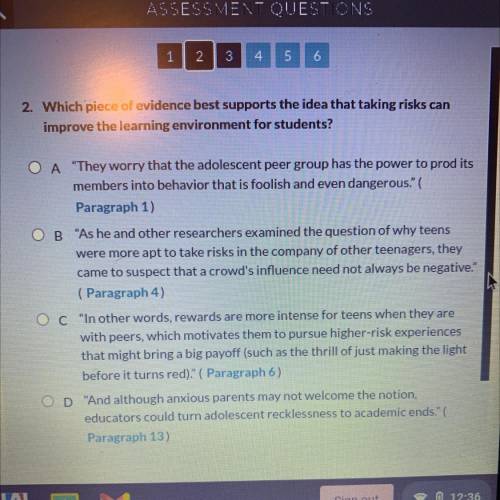

Answers: 1


Other questions on the subject: English

English, 22.06.2019 03:00, mbrooks6077
Read the excerpt from the poem "growing up italian" by maria mazziotti gillan and answer the question that follows. when i was a little girl, i thought everyone was italian, and that was good. we visted our aunts and uncles, and they visted us. the italian language smooth and sweet in my mouth. in kindergarten, english words fell on me, thick and sharp as hail. i grew silent, the italian word balanced on the edge of my tongue and the english word, lost during the first moment of every question. source: gillan, maria mazziotti. "growing up italian." poetrymagazine. com. poetry magazine, n. d. web. 30 mar. 2011. what is the tone of this poem? what does the tone reveal about the speaker of the poem and the conflict she faces? based on this excerpt, what can you predict about the theme of the poem?
Answers: 1

English, 22.06.2019 16:30, shavonfriend27
Which detail from "the city without us" most clearly shows us that nature is more powerful than it appears this is for apex 2019 a. the great size of the trees that grow in the new york botonical garden b. the worthlessness of the money left in the bank vaults that remain intact c. the hurricanes that frequently pummel us soil coastal cities d. the size of the japanese insect that can kill hemlock trees
Answers: 3

English, 22.06.2019 23:00, momo26590
Read both passages and answer the question. passage 1: excerpt of john muir's "calypso borealis" [1] after earning a few dollars working on my brother-in law's farm near portage [wisconsin], i set off on the first of my long lonely excursions, botanising in glorious freedom around the great lakes and wandering through innumerable tamarac and arbor-vitae swamps, and forests of maple, basswood, ash, elm, balsam, fir, pine, spruce, hemlock, rejoicing in their bound wealth and strength and beauty, climbing the trees, revelling in their flowers and fruit like bees in beds of goldenrods, glorying in the fresh cool beauty and charm of the bog and meadow heathworts, grasses, carices, ferns, mosses, liverworts displayed in boundless profusion. [2] the rarest and most beautiful of the flowering plants i discovered on this first grand excursion was calypso borealis (the hider of the north). i had been fording streams more and more difficult to cross and wading bogs and swamps that seemed more and more extensive and more difficult to force one's way through. entering one of these great tamarac and arbor-vitae swamps one morning, holding a general though very crooked course by compass, struggling through tangled drooping branches and over and under broad heaps of fallen trees, i began to fear that i would not be able to reach dry ground before dark, and therefore would have to pass the night in the swamp and began, faint and hungry, to plan a nest of branches on one of the largest trees or windfalls like a monkey's nest, or eagle's, or indian's in the flooded forests of the orinoco described by humboldt. [3] but when the sun was getting low and everything seemed most bewildering and discouraging, i found beautiful calypso on the mossy bank of a stream, growing not in the ground but on a bed of yellow mosses in which its small white bulb had found a soft nest and from which its one leaf and one flower sprung. the flower was white and made the impression of the utmost simple purity like a snowflower. no other bloom was near it, for the bog a short distance below the surface was still frozen, and the water was ice cold. it seemed the most spiritual of all the flower people i had ever met. i sat down beside it and fairly cried for joy… [6] oftentimes i had to sleep without blankets, and sometimes without supper, but usually i had no great difficulty in finding a loaf of bread here and there at the houses of the farmer settlers in the widely scattered clearings. with one of these large backwoods loaves i was able to wander many a long wild fertile mile in the forests and bogs, free as the winds, gathering plants, and glorying in god's abounding inexhaustible spiritual beauty bread. storms, thunderclouds, winds in the woods—were welcomed as friends. passage 2: william wordsworth's "i wandered lonely as a cloud" [1]i wandered lonely as a cloud that floats on high o'er vales and hills, when all at once i saw a crowd, a host, of golden daffodils; [5]beside the lake, beneath the trees, fluttering and dancing in the breeze. continuous as the stars that shine and twinkle on the milky way, they stretched in never-ending line [10]along the margin of a bay: ten thousand saw i at a glance, tossing their heads in sprightly dance. the waves beside them danced; but they out-did the sparkling waves in glee: [15]a poet could not but be gay, in such a jocund company: i gazed—and gazed—but little thought what wealth the show to me had brought: for oft, when on my couch i lie [20]in vacant or in pensive mood, they flash upon that inward eye which is the bliss of solitude; and then my heart with pleasure fills, and dances with the daffodils. both passages use the word "lonely" in their first sentence. in a paragraph of 4-6 sentences, explain how the discovery of a plant affects the authors' loneliness? what does each experience reveal about the power of nature? use evidence from both texts to support your answer.
Answers: 3

You know the right answer?
PEER PRESSURE HAS A POSITIVE SIDE
Which piece of evidence best supports the idea that taking risks...
Questions in other subjects:


Spanish, 18.11.2020 19:40


Mathematics, 18.11.2020 19:40


English, 18.11.2020 19:40

Mathematics, 18.11.2020 19:40






